Cavan Heritage Report Published Online
 cavan |
environment |
press release
cavan |
environment |
press release  Wednesday September 22, 2004 02:56
Wednesday September 22, 2004 02:56 by Michael Lynch - Red Branch Heritage
by Michael Lynch - Red Branch Heritage redbranch at oceanfree dot net
redbranch at oceanfree dot net
Important Heritage Sites Must Be Protected
Red Branch Heritage have decided to make the full text of their recent heritage report on sites in the Denn area of County Cavan available to the general public through the web in their continuing efforts to have these important archeological sites protected.
Introduction
This Report has being drafted by The Red Branch Heritage group to highlight an important heritage area in mid County Cavan with a considerable amount of archaeological sites situated within this small catchment area.
It is the earnest wish of the authors that those who are appointed as custodians of such sites and with the implementation of the planning laws and guidelines will take account of the views of those who believe in the protection of our national treasure of historical sites.
For the purposes of this report we will refer to the area as the Denn Heritage Area, as by far the greater part of this area lies within the parish of Denn, with smaller parts located in neighboring Crosserlough and Lavey parishes.
The aim of Red Branch Heritage in drawing up this report is to encourage the full implementation of the spirit of the County Cavan Development Plan 2003-2009, in its firm commitment “to protect all listed archaeological items and sites from development that may prejudice their integrity and value” (page 30).
We also hope this report will lead to the Denn Heritage Area being designated a Special Policy Area, which would then afford this area protection from any development which would have a negative impact on archaeological sites within this catchment area or cause damage to the scenic value of the area, as has unfortunately already occurred.
We draw particular attention to the two most important sites in the Denn area, the Black Pigs Dyke or Race located at Ardkill More, on the parish boundary of Denn and Crosserlough, an ancient earthwork possibly built for defensive purposes two thousand years ago in the defense of the ancient province of Ulster and the much-neglected Banagher Burial and Ritual complex, which contains one of only two known passage tombs in County Cavan, both unfortunately damaged. Both these sites have suffered from neglect and damage and we will deal in more detail with these matters in this report.
Red Branch Heritage
Introduction
This Report has being drafted by The Red Branch Heritage group to highlight an important heritage area in mid County Cavan with a considerable amount of archaeological sites situated within this small catchment area.
It is the earnest wish of the authors that those who are appointed as custodians of such sites and with the implementation of the planning laws and guidelines will take account of the views of those who believe in the protection of our national treasure of historical sites.
For the purposes of this report we will refer to the area as the Denn Heritage Area, as by far the greater part of this area lies within the parish of Denn, with smaller parts located in neighboring Crosserlough and Lavey parishes.
The aim of Red Branch Heritage in drawing up this report is to encourage the full implementation of the spirit of the County Cavan Development Plan 2003-2009, in its firm commitment “to protect all listed archaeological items and sites from development that may prejudice their integrity and value” (page 30).
We also hope this report will lead to the Denn Heritage Area being designated a Special Policy Area, which would then afford this area protection from any development which would have a negative impact on archaeological sites within this catchment area or cause damage to the scenic value of the area, as has unfortunately already occurred.
We draw particular attention to the two most important sites in the Denn area, the Black Pigs Dyke or Race located at Ardkill More, on the parish boundary of Denn and Crosserlough, an ancient earthwork possibly built for defensive purposes two thousand years ago in the defense of the ancient province of Ulster and the much-neglected Banagher Burial and Ritual complex, which contains one of only two known passage tombs in County Cavan, both unfortunately damaged. Both these sites have suffered from neglect and damage and we will deal in more detail with these matters in this report.
Compiled by
Susan Hayes
Claire Dunleavy
John O’Reilly
&
Michael Lynch
The Black Pigs Dyke and Hilltop Enclosure
Ardkill More, Carrickaboy, Co. Cavan.
This site has during the past four decades suffered from the kind of destruction, which it had avoided during the previous centuries. Ironically the rocky terrain, which had probably saved it from damage in the past, became the cause of the large-scale destruction of more recent times, i.e., quarrying.
An illegal quarrying operation began at the lower levels of Ardkill More mountain during the nineteen seventies and rock continued to be extracted from the site for a number of years. We believe it was during this illegal quarrying operation that a substantial section of the linear earthworks were destroyed. It is to the eternal shame of the relevant authorities that this destruction was allowed to continue unchecked.
The quarry ceased operations for a short time, however during the nineteen nineties the quarry owners made an application to Cavan County Council to reopen quarrying works at the Ardkill More site. A number of local objections were submitted to the planning authority, however despite these local concerns, the illegal operations of previous years and the presence of a two thousand year old archeological monument on this western slope of the hill, the quarry was given planning approval. Cavan County Council has failed to give any explanation for this incredible decision.
As if this was not bad enough, during 2003, a purchase was made by the quarry owners of another large section of the western slope of the hillside and before long earthmoving machinery was clearing a roadway across a further stretch of Ardkill More. At present a considerable area has being cleared without planning approval, although as we write we understand an application for approval for this extension may be imminent.
In the County Cavan Development Plan 2003-2009 the council has clearly stated its commitment to protect such sites as Ardkill More, indeed earthworks are specifically mentioned (page 28) as items of Archaeological and Historic Importance.
We fear for the future of this site if the planning authorities do not act in a determined manner on such commitments.
The visual damage already caused to the scenic aspect of Ardkill More mountain is sad to view. A very real blight has being imposed on the local landscape. Indeed if one were to require a good example of how not to locate a quarry from a landscape and scenic aspect alone, one need travel no further than Ardkill More, Carrickaboy, County Cavan.
It is the earnest wish of the authors of this report that even at this stage some sense of respect and concern for this archeological site may lead to moves to preserve it from any further destruction. This site is County Cavan’s only surviving visible section of the Black Pigs Dyke or Worm Ditch and deserves considerably more concern and attention than it has received over the past three decades.
It should be also noted that located on the summit of Ardkill More are the remains of a listed enclosure of unknown date. It is an unlikely location for a dwelling site as the site is totally exposed and barren. This leads one to speculate that this enclosure may have being related to the earthworks below. Possibly some form of lookout post or small encampment site or even a damaged cairn perhaps?
We have noted with disappointment that in the Archeological Inventory of County Cavan under the listing for The Black Pigs Dyke (Linear Earthworks ref. 180 Page 35) it appears the authors who visited the site during May 1992 failed to even defiantly locate the remains of the Dyke, confusing it with “a natural ravine”. This entry does a great disservice to the site. Where were they looking? Any local could have easily showed its location. Although the terrain can be trying, especially during the summer months, as one has to contend with bramble, thick bracken and gorse, the authors of this report had no great difficulty locating the earthworks, with the sad exception of the quarry area.
Michael Lynch
Red Branch Heritage.
Wednesday, September 22, 2004
Banagher Burial and Ritual Complex
Banagher, Carrickaboy, Co. Cavan.
On an area of high ground near Slieve Glah mountain at Banagher are located a complex of burial and ritual sites of considerable importance. Like many such sites this one commands an extensive view.
Sadly this site has also suffered from damage. At present the complex contains, two barrows, two stone circles, an embanked enclosure or henge and two megalithic tombs. Sadly another megalithic tomb, which was recorded during a survey, carried out by de Valera and O’Nuallain in 1965 has since being destroyed. This destroyed monument was a court tomb and was destroyed since 1965 when it was surveyed. Duchas have erected a number of notices on concrete pillars at the site warning against causing damage to the surviving monuments. This is most welcome and is a system that should be extended to other sites. However Duchas is now largely defunct and has being incorporated into the National Monuments section of the Department of the Environment. Hopefully this will not have a negative impact on such protection for sites such as Banagher. It would also be welcome if such notices included information on the monuments themselves such as their history and approx. age etc. One of the two surviving tombs appears to be a passage tomb, one of only two known in County Cavan. A number of cists and several pots were found in the cairn. This cairn is 22m in diameter and 1m in height and round in outline. The cairn is now ruined and is surrounded by a stone circle of twelve stones, five now upright and the others prostrate. One of a number of prostrate stones beside the cairn is decorated with passage tomb art. (Photo Next Page) A short distance from this complex to the SW at Moher is located a lone standing stone. Many such burial sites throughout Ireland were rifled by treasure hunters in past centuries and suffered much damage. Even the Newgrange site in the Boyne valley Co. Meath suffered such vandalism. These so called treasure hunters were obviously not well informed on historical facts, as it appears they were looking for gold treasure at Stone Age sites.
It was quite common for Neolithic sites to be used later during the Bronze Age period as ceremonial and burial places. The original passage tombs and Megaliths would later be used for the burial of usually cremated remains during the Bronze Age period. The stone circles and henge’s are a feature of the Bronze Age period as are the barrows. It shows that the later peoples showed continuing respect for the sacredness of these sites. Such evidence also exists at the Boyne Valley sites, where standing stones and henge’s were later erected around such passage tombs as Newgrange and Knowth.
Why Banagher is not included in the Cavan Co. Council inventory of special sites when it is recognised, as a site of archeological importance even by the relevant government departments is quite extraordinary.
Claire Dunleavy
Red Branch Heritage
Wednesday, September 22, 2004
Church Remains, Graveyard, Holy Wells, & Barrow
Carrickaboy Glebe, Carrickaboy, Co. Cavan.
Near Denn Cross are a number of important items of Ecclesiastical Remains. Denn old graveyard is but one of many important pre-reformation church sites throughout Ireland.
This graveyard contains many gravestones dating from the 18th century. At the SE end of the churchyard are to be found the surviving lower portions of the original pre-reformation Denn Church. Davies the noted archeologist visited the site in 1948 and also recorded a broken slab with a ringed cross in low relief within the graveyard.
The Denn old graveyard is sadly neglected and overgrown for some time. It would be a rewarding undertaking by the local community to have a total cleanup of this ancient cemetery. Many of the ancestors of Denn people today lie within this burial ground. Davies also suggested that the pillar stone located at the Church of Ireland churchyard at Denn Glebe originated at the old Denn graveyard.
Davies writing for the Irish Tourist Survey in 1940 described two open springs on a hillside with “ a little walling at the back”. The springs or spring as it is today is located just outside the old graveyard to the SW. These two springs are marked on all OS maps as Holy Wells. They have now being amalgamated and are utilised as a large watering hole for cattle. We are concerned about the lack of awareness and neglect that can lead to this needless damage to these important local items of historical importance. Sadly in more recent times the respect and pride local communities used to have in their history and culture seems to have being eroded.
Sited east of the summit of the hill containing the holy well is to be found a barrow. This has being called locally ‘The Saints Grave or Flags of Denn’. This barrow is a small circular raised area enclosed by a low bank of earth and stone. No fosse. At centre is a low irregular grass covered mound of unknown significance.
John O’Reilly
Red Branch Heritage
Wednesday, September 22, 2004
Saint Dympna’s Church, Holy Well, and other Lower Lavey sites.
Today only the foundations of St. Dympna’s, also called St. Dabnet’s Chapel survive, aligned N-S (int. dims. 13.2m N-S; 7.4m E-W). Within it is a low irregular – shaped cairn of large and small stones which is said to represent the ‘Saint’s Grave’ (local information) and according to Davies (1948, 111-2) was formally enclosed by upright slabs, only two of which are still in situ at that time. He also noted an alter in the south corner which appeared to him to be of recent construction, and some small slabs set on edge and buried in turf outside the north wall of the church.
A total of nine architectural fragments including two stone heads, originally from the church, have being erected in its vicinity and act as stations.
A holy well is situated in the bed of the river immediately below the church. Water from this holy well is reputed to cure ailments, particularly mental illness. Davies commented in 1948 that the church is ‘apparently pre-reformation; but it is not shown on any early map, nor did the townland belong to the church, so it may have been a private oratory.
In 1934 Very Rev. Henry Galligan, PP., had a monument to Saint Dympna erected along the river, depicting her martyrdom.
An annual Pattern was held at the Holy Well, which dated back to the 16th century. This religious event was revived by the above-mentioned Father Galligan during the nineteen thirties and was held on the 15th of August for a number of years. Saint Dympna was martyred in Belgium, reputedly by her jealous father. At least one group of visitors from Belgium has visited Lavey because of this connection with the saint.
There is also a local tradition that an ancient graveyard associated with the St. Dympna’s church, which was situated 450m to NNE (local information) on low-lying ground close to a stream.
Davies recorded another early church site close the main Cavan-Dublin road during his visit to the area in 1948. The Lavey Sheela-na- gig figure was also discovered at this site.
The Lavey Sheela-na-gig is now on Display at the Cavan County Museum, Ballyjamesduff.
The origin of these figures is uncertain. Some theories suggest they represent Celtic fertility goddesses, while others claim they were erected on churches to warn the faithful against the sins of the flesh. Although most numerous in Ireland, they are also to be found throughout Britain and other parts of Western Europe.
Susan Hayes
Red Branch Heritage
Wednesday, September 22, 2004
Conclusions
The Denn catchment as we see is rich in archeological sites dating from the New Stone Age up to the eighteenth century. To have these sites recognised for their importance is the minimum that we would expect from the local authority. Further to this Cavan County Council must have this area declared an area of special historical and archeological importance and included as such in the County Development Plan. This is needed in order to protect these sites from damage or total destruction as has happened in the area already.
We are particularly concerned as to the future of the Black Pig’s Dyke linear earthworks at Ardkill More Mountain. The local authority has a duty to preserve Cavans only surviving stretch of this monument from further damage. The destruction of the landscape at Ardkill More has being greatly worsened by the unauthorised removal of shrubbery and topsoil from the newly purchased section high on the western slopes of the mountain. The quarry site has now become a real eyesore and this extension must not be allowed to continue and the area of this latest unauthorised work should be re-landscaped with soil in order to bring about a renewal of growth. It is time to have a serious look at the long-term future of quarrying at Ardkill More. It is quite clear this site is totally unsuitable for quarrying with regard to its elevated location and the fact that an important archeological site lies in its immediate vicinity. The quarry owners might be encouraged to consider sourcing a more suitable quarry site and phasing out their operations at Ardkill More. An archeological excavation of both the linear earthworks and the site on the hill summit could help answer some of the many questions about the purpose of the earthworks and what was the enclosure on the barren summit used for. This is an important part of the local heritage and the heritage of County Cavan and Ulster.
The Banagher site is one of great importance. When our team including our archeological adviser Claire Dunleavy visited, this ancient complex of sites impressed them greatly. It is obvious that this elevated site was an important and sacred location of ritual and burial to the ancient peoples of the locality over a long period of time from the Neolithic to the Bronze Age. A proper archeological excavation being carried out can gauge just how important Banagher is. Sadly this site seems to have being damaged in the distant past, most probably by treasure trove hunters. Most disturbing was to learn that further down the southeastern slopes of Banagher hill a court tomb has being completely destroyed in fairly recent times. To find that such an important archeological item could be just taken away almost defies belief and should be proof if proof were needed of the need to tighten up our laws and regulations with regard to causing damage to such sites.
There seems to be a number of small private quarries in evidence in the locality of the Banagher sites. We presume these are unauthorised operations. The danger with such private quarries is that as they are unregulated there is the possibility that historical remains on rocky terrain may be removed in order to proceed with this work. While Duchas have erected notices at the main sites on the hill summit, this is a system that should be applied to all archeological sites in order to clear up any doubt about their importance. There is no room for complacency about this issue if we are serious about protecting our heritage. That Banagher is omitted from Cavan County Councils Development plan seems to be an amazing oversight and one that should be quickly remedied.
The ancient churchyard at Carrickaboy Glebe is as stated in a state of neglect at present. Either the local parish or the local authority should carry out a regular cleanup of this important site. Indeed we noted that there are grave plots still in use in this cemetery and it is surely unfair to have the cemetery in such a state that access for relatives to their family plots is at present virtually impossible. Also many overseas visitors are interested in tracing their family history and their impressions on visiting Carrickaboy churchyard cannot be a favorable one. It is also a pity that the holy wells site nearby has being interfered with, as it seems likely these wells were connected to the ancient church of Denn.
The Lavey site thankfully still seems to be held in high regard in the locality. Hopefully this will continue. The Cusack family has being very good stewards of this site on their lands and have provided access to St. Dympnas well to those wishing to visit. This is an important site, a treasure to the parish of Lavey and one we trust they will continue to value. Maybe more could be done with regard to promoting the site and having the ruins of the old church surveyed by archeologists and having some restoration work carried out which would not interfere with character of the ruined church.
Finally we urge Cavan County Council to act without delay in the spirit of its stated commitments to protect such monuments, to bring these important sites into its list of special sites of archeological importance in the County Development Plan, and in doing so take an important step in protecting them from damage or destruction.
Red Branch Heritage.
Wednesday, September 22, 2004
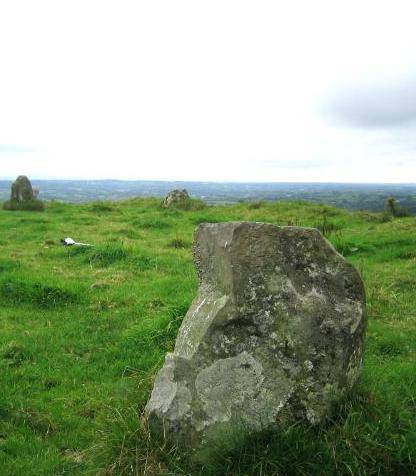
The Smaller of Two Stone Circles, Banagher
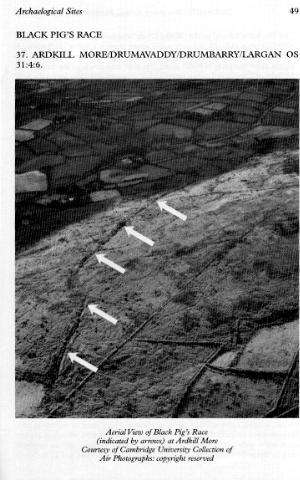
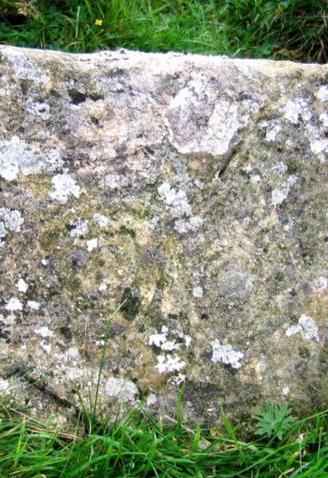
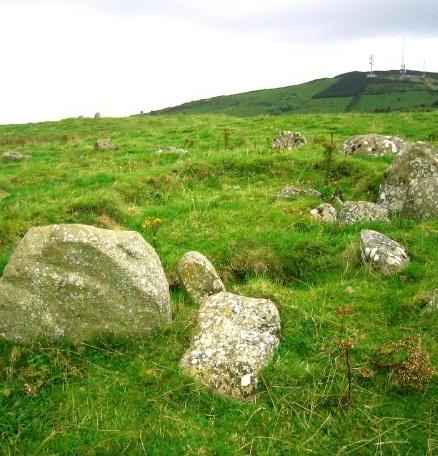
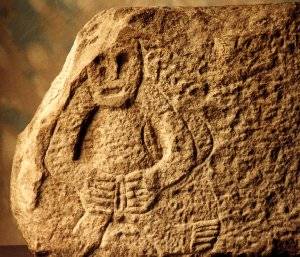
Comments (1 of 1)
Jump To Comment: 1'Duchas have erected a number of notices on concrete pillars at the site warning against causing damage to the surviving monuments. This is most welcome and is a system that should be extended to other sites. However Duchas is now largely defunct and has being incorporated into the National Monuments section of the Department of the Environment. Hopefully this will not have a negative impact on such protection for sites such as Banagher. '
Martin Cu Cullen ,the hound from Hell destroys whatever his department touches...
Indymedia Ireland is a media collective. We are independent volunteer citizen journalists producing and distributing the authentic voices of the people. Indymedia Ireland is an open news project where anyone can post their own news, comment, videos or photos about Ireland or related matters.